The 9.7" iPad Pro Review
by Brandon Chester on June 1, 2016 9:00 AM ESTSystem Performance
Like the larger iPad Pro, the 9.7" iPad Pro uses Apple's A9X SoC. Apple is never very forthcoming with details like the clock speed for the CPU, GPU, and amount of DRAM. What we can determine about the SoC is that Apple has maintained the 2.2GHz maximum clock speed from the larger iPad Pro, while reducing clocks on the GPU and dropping to 2GB of LPDDR4 RAM.
The RAM situation on the 9.7" iPad Pro is somewhat surprising for a few different reasons. In their always-excellent teardown, the iFixit crew discovered that the smaller iPad Pro only had one Samsung 2GB LPDDR4 memory chip. This explains how Apple scaled down from 4GB to 2GB - the larger iPad Pro had two chips - but it also means that Apple has changed the amount of memory bandwidth available to the A9X SoC as well.
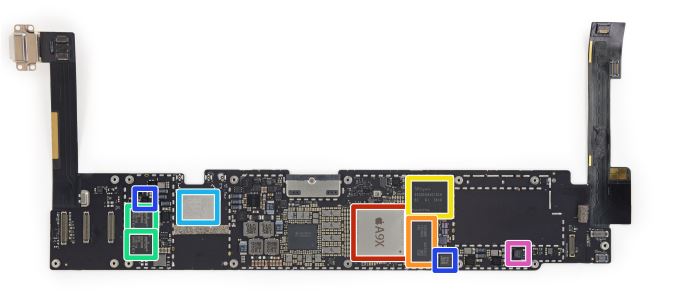
9.7" iPad Pro Logic Board (Image Courtesy iFixit)
To date, all Apple X-series SoCs have shipped with a larger 128-bit memory bus, and until now, Apple always fully populated that bus. So the 9.7" iPad Pro is an outlier in that regard, as this is the first time we've seen an X-series SoC with only the first 64-bit half wired up to a single memory chip in this fashion. In that respect it's a surprising decision from Apple, in part because of the importance of memory bandwidth in feeding the large, powerful GPUs on the X-series SoCs.
Consequently there is going to be more to the 9.7" iPad Pro than just the original Pro in a smaller chassis. The 9.7" iPad Pro should match the larger model in anything that depends heavily on CPU speed or memory bandwidth, while falling behind to some degree in GPU-bound tests. The 12 cluster PowerVR Series7XT GPU inside A9X will be having to make do with less memory bandwidth, though offset to some degree by the lower resolution of the screen.
With the above in mind, I quickly benchmarked the 9.7" iPad Pro on a couple of our memory bandwidth benchmarks. The results are somewhat inconclusive.
| Geekbench 3 Memory Bandwidth Comparison (1 thread) | ||||||
| Stream Copy | Stream Scale | Stream Add | Stream Triad | |||
| 9.7" iPad Pro | 17.1 GB/s | 11.5 GB/s | 12.9 GB/s | 12.8 GB/s | ||
| 12.9" iPad Pro | 20.8 GB/s | 15.0 GB/s | 15.3 GB/s | 15.1 GB/s | ||
I say "inconclusive" because although the 9.7" iPad Pro consistenly scores lower in Geekbench 3's memory bandwidth benchmarks and other memory benchmarks, it's never a 50% drop as we get on paper. In practice these numbers are far from the maximum memory bandwidth A9X is capable of, and I suspect that the CPU paths simply aren't wired in such a fashion that they can fully saturate A9X, especially given the fact that it's the GPU that needs the bandwidth more. So although we see some impact of the narrower memory bus in dedicated memory bandwidth benchmarks, these can't paint a very clear picture. It's going to be our high level GPU performance benchmarks that really give us an idea of the impact of reduced memory bandwidth.
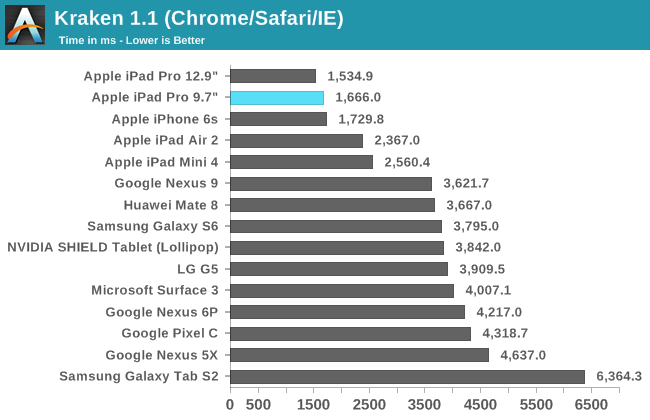
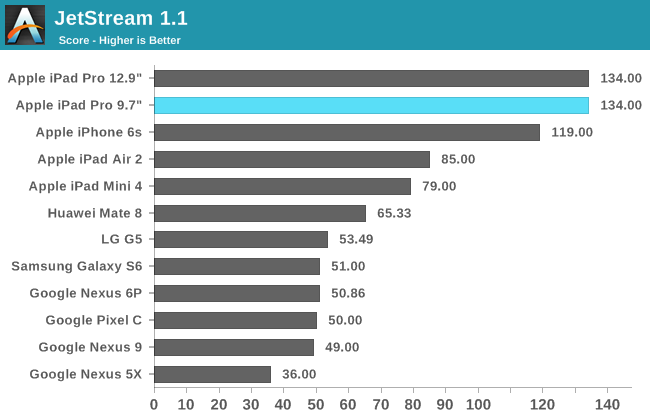
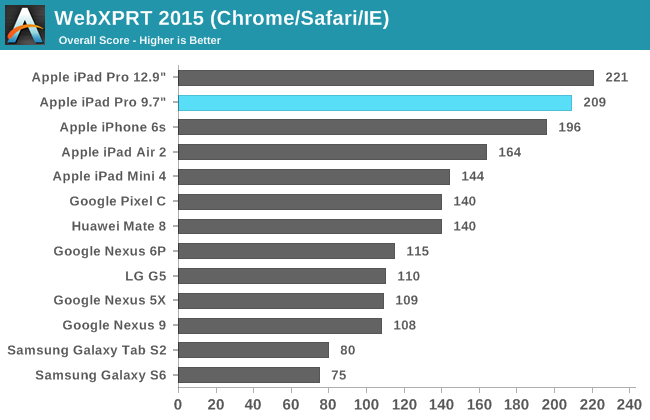
With the 9.7" iPad Pro having the same two 2.2GHz Apple Twister cores as the 12.9" model, it's no surprise to see the two neck and neck in our browser tests. In Jetstream 1.1 the two achieve the exact same score, while in the other two tests the 9.7" model is a bit slower, but with the gap being small enough to attribute to testing variance. With A9X Apple moved back to a dual-core CPU from A8X's tri-core CPU, with the move to TSMC's 16nm FinFET process allowing peak clock speeds to go up by 700MHz. Because JavaScript performance is mostly bound by a device's single threaded performance, A9X came with a significant performance uplift during web browsing. Given that the 12.9" iPad Pro offered the best web browsing performance of a mobile device, bringing that performance to the 9.7" iPad makes for a notable improvement over the performance of the iPad Air 2.
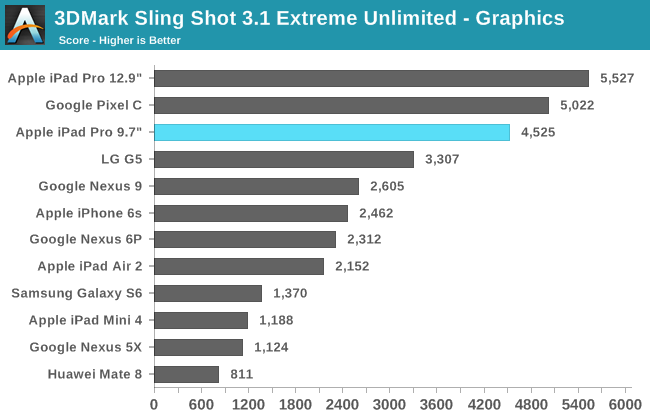
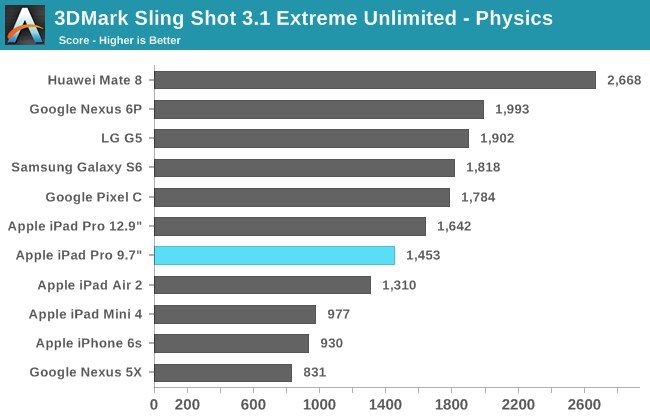

The 9.7" iPad Pro does well in 3DMark's graphics test, but like Ice Storm it doesn't do well in the physics test. It seems that this test is programmed in a similar way to Ice Storm, and in that sense I'm not sure how representative the physics test is of real-world performance because with an actual mobile game you wouldn't use highly random memory access and data structures with heavy memory dependencies when it would perform very poorly on your target devices. In any case, you can see that the 9.7" iPad Pro places third overall, with the 12.9" model at the top of the chart and the Pixel C coming right behind it.
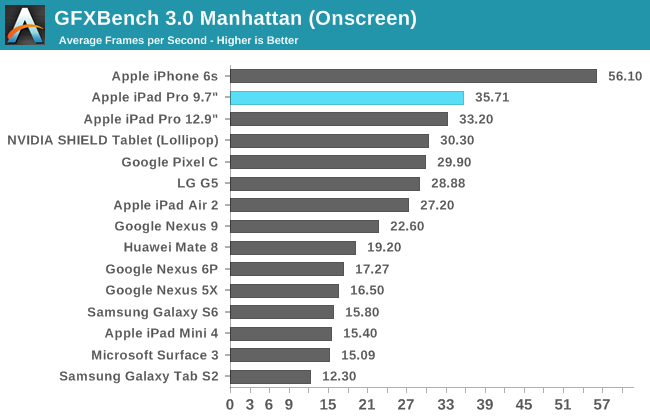
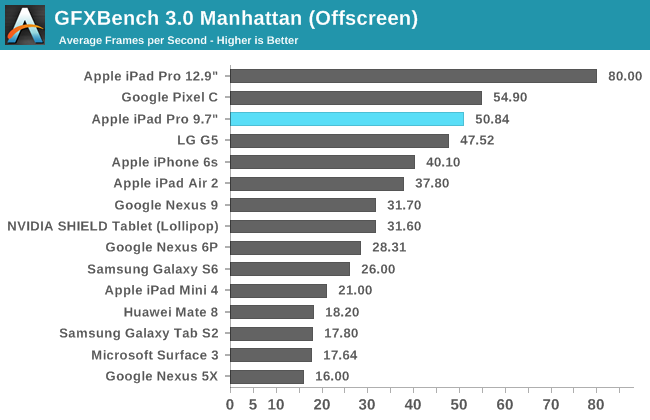
GFXBench 4.0 Car Chase hasn't made its way to iOS yet, and so for now we're still using GFXBench 3.0 Manhattan for iOS devices. Given that the iPhone 6s is the only phone that hits Vsync in this test, it's still a very relevant benchmark in how it represents the level of visual fidelity that a mobile game can currently have on high end devices while still performing well. In the off screen test we can see the impact of the 9.7" iPad Pro's lower clocked GPU combined with the reduced memory bandwidth,, with the smaller iPad performing around 37% lower than that of the 12.9" iPad Pro. The on screen test tells an interesting story though. Both models of the iPad Pro have roughly the same performance at their native resolutions in this test, which could indicate that Apple was targeting the same performance relative to the display resolution when configuring A9X and its memory, in order to manage heat and energy usage in a smaller iPad Pro.
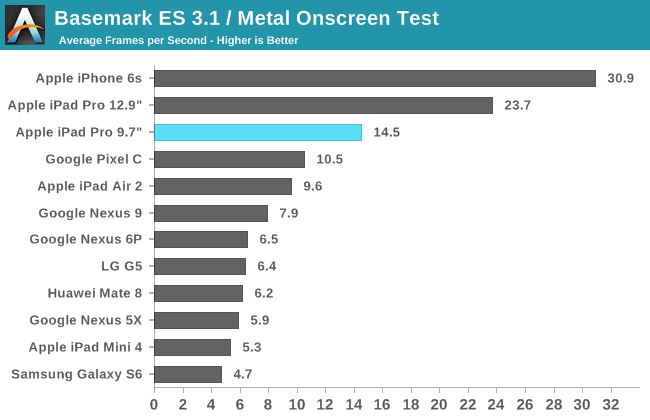
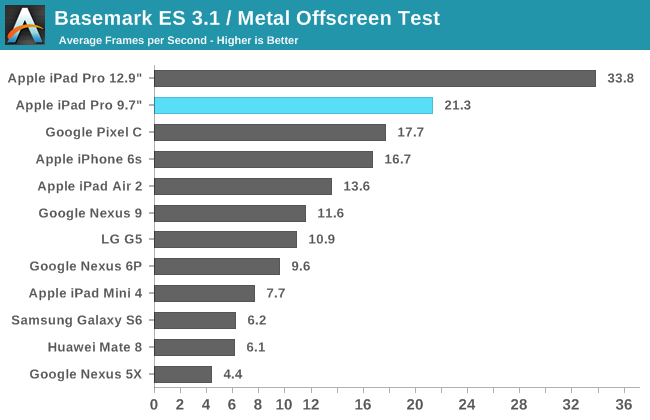
While I didn't have enough data to use BaseMark ES 3.1 at the time of my iPhone SE review, we've since tested enough older devices to deploy it. One could think of this as the successor to BaseMark X, which we retired some time ago before we officially deployed a new mobile test suite for 2016. Once again, both models of the iPad Pro sit above the other tablets on the chart. The iPhone 6s places first in the on screen test due to its relatively low resolution, but without that there the iPads would hold the top two spots in both tests.
NAND Performance
Something that Apple publicized with their A9 and A9X SoCs is improved NAND performance. NAND performance isn't discussed very much in reviews, but it's a very critical aspect of device performance and issues with it tend to cause a device's performance to crash months down the line rather than right off the bat, which makes it something of an invisible problem if you don't look for it during a review. We've seen previously that Apple has been using their own SSD controller in the current generation of iOS devices, and the 9.7" iPad Pro continues this.
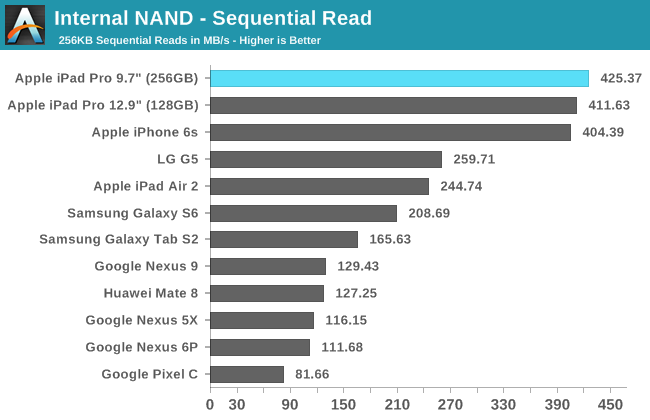
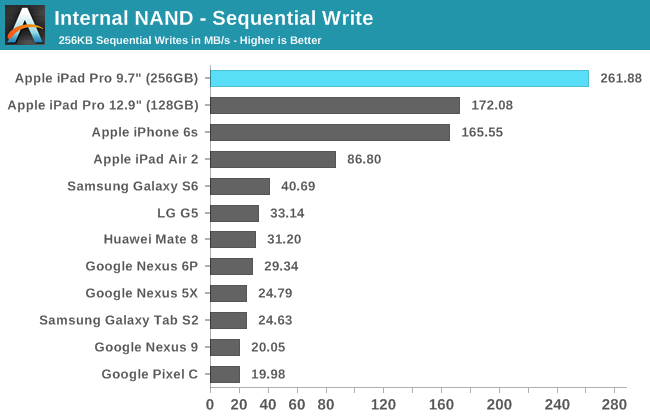
For this review I was sampled the 256GB model of the 9.7" iPad Pro. Because SSDs exploit parallelism heavily to improve performance, a 256GB iPad could improve NAND write performance over the lower-capacity models if it has a greater number of dies. In this case we see that sequential read performance improves a bit, while sequential writes improve dramatically as expected. There's not a lot to say here, as Apple has an enormous lead over the competition in this area.










144 Comments
View All Comments
ragingfighter - Wednesday, July 13, 2016 - link
If $1000 for a tablet is something you could afford that's fine but keep in mind $1000 can get you a good laptop as well I don't not your choice and this is not a criticism to what you chose for your workflow so I don't want you to take it as such it's just a general opinion.syxbit - Wednesday, June 1, 2016 - link
Google should be ashamed of themselves with those internal NAND (sequential write) results. The iPad is 10x the performance of the Pixel C...Wolfpup - Wednesday, June 1, 2016 - link
I wonder if that's with encryption on or off? I sure hope that's with it on :-OI love that iOS just comes with it on now, and users don't need to know anything, manage it, etc., NOR worry about performance.
I know my Android tablet was seriously dirt slow...well, dirt slow in general, and in storage performance specifically. (What blew me away was my equivalently speced Surface running close-to-full-Windows ran circles around it...which is like WHAAAAAT, the limited mobile OS is supposed to at least be faster LOL)
grayson_carr - Thursday, June 2, 2016 - link
New Android devices all come with encryption on as well. And while Apple does hold a huge lead in NAND performance, I haven't noticed the storage performance of Android devices negatively impacting day to day use since the Nexus 6.ragingfighter - Wednesday, July 13, 2016 - link
I think it's the cost of having a filesystem a more Advanced interaction with it all and having the full on options of tweaking and placement and so on that also can bog down an operating system. A lot of how we perceive a ui or user interface or operating system is in which the speed and workflow comes across such as finding what you're trying to work on how fast it comes on screen how much time you save. With iOS, either not have a file system as you just have apps apps that do specific things. Depending on what type of workflow you have this can be easier or harder you do not have to look through a lot of submenus to find a file or something you're working on. Is your work something that you can transferred to the cloud and just so you have access to other devices after it's done or do you work on a tablet at home and have a come up on your computer at work?When you start getting into the sub areas of an operating system terminal command lines and all types of other advanced features and code and stuff that is one in a way I believe the operating system gets perceived as cluttered. Even something as simple as removing programs and just drag them to the garbage can for being deleted is something common sense and I was amazed that is not implemented across all operating systems. The complexity of having to go to your ad and remove programs list on windows to delete something still is amazing to me that people would have to do such a thing for such a basic function Especially during the year 2016. The thing that makes iOS really good is also the same thing that makes it really bad for some and that is its basic simplicity iOS is at its greatest for young children for people that have a writing type of workflow for consumption, but especially for the elderly that do not have as much technical know-how as others have in life I know I have relatives that if it wasn't for the iPad they would still be thinking of 56K not know how to check their emails and truly enjoy the web. They are not great typists not nearly there not know what the Home row is. In this regard voice dictation gives them another way to interact with their tablets which are computers and allows them to use them much better than without.
Hemlocke - Thursday, June 2, 2016 - link
It shows in daily usage, too. My Pixel C went out the door to get my Pro 9.7, and after a few hours, I know I made the right choice. The Pixel was irritating, with hiccups and stutters when there is no reason for it. My Air 2 was a better tablet.lucam - Wednesday, June 1, 2016 - link
Hi Brandon,There is the new GFX Bench 3.1 available for IOS too; especially the new one 1440 resolution.
It's worth trying it.
Oyeve - Wednesday, June 1, 2016 - link
Would be nice if you actually FINISHED your S7 review to see those pic samples against this tablet. I own the 9.7 pro and the S7 and the S7 just blows the pro away. Hmmm, thats probably why you guys never finished the S7 review. It would crush your apple love.Brandon Chester - Wednesday, June 1, 2016 - link
I stated in the article that the sensor used in the 6s/SE/9.7" is not the best sensor in a smartphone. I would argue that the Galaxy S6 is superior, let alone 2016's Android devices. Your perception of bias is unfounded.KPOM - Wednesday, June 1, 2016 - link
Apple haters gonna hate. For whatever reason they can't accept a decent review of an Apple product, even one that points out its flaws.I like AT and am glad the new ownership doesn't seem to have affected its editorial independence. Kudos to Ryan and the whole team.